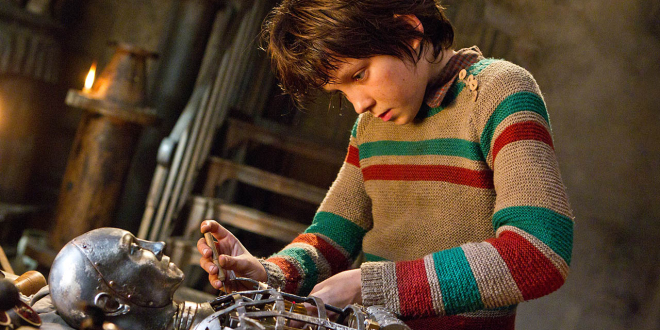
A. Twentieth 1 century visual conventions — organized by a competitive collusion between cinema and television — did not survive the multiple forms and applications of digital media that put into play the multiplication of screens, the differentiation of production practices and processes of diffusion, and the rise of audience participative experiences.
The brilliant paradigm of “remediation” (Bolter & Grusin, 1999), applied to twentieth century media, was rooted only in the first phase of the digital era when Web 2.0 and beyond were merely remote perspectives. It is clear, then, that this paradigm does not suffice to understand what happened next. In 2001, Lev Manovich described a strict link between media arts and new modes of fruition typical of cinema spectators and video game players such as in the antithetical Doom and Myst, the former characterized by a “breathtaking pace”, the latter on the contrary absolutely “slow” (pp. 213-218). Seven years later, he defined, in Software Takes Command, the cultural supremacy of software and remix technologies over other forms that compose the digital audiovisual landscape (Manovich, 2008). Henry Jenkins also underlined the rising role of crowdsourcing in production, diffusion and participation in the audiovisual field. Moreover, the subtitle of his famous Convergence Culture, “Where old and new media collide”, strongly implies the competitive aspect of grassroots productions (Jenkins, 2007).
In the last decade, most cinema and television scholars have assimilated both the theories of Manovich and Jenkins. However, a new phase is at hand, and it became clear in the technological and cultural limit regarding the appreciation of grassroots products. In fact, when they are presented to a mainstream public, conscious of all the entertaining sophistications, and not to a motivated, niche one, problems arise. Mainstream cinema and television acquire state of the art digital technologies through expensive investments, increasing the level of visual conventions: augmented reality, enhanced vision, full HD, 3D.
After the initial enthusiasm for user-generated contents (UGCs), the twentieth century structures of media industry managed to come back, first of all with television: pay TV, pay per view with non-linear fruition, and HD. This high grade vision quality, along with the point of view of the spectator, became crucial elements. A certain aesthetic of definition pervades the television medium, starting more or less around 2005 with the widespread diffusion of large, flat screens and broadband internet connections that allows a wider and more detailed signal 2.
Cinema in particular responded to the success of mash-up practices and UGCs highlighted by Jenkins, introducing new sophisticated techniques such as digital 3D and HD. Digital 3D does not share anything with the primordial 3D or with the one that emerged around 1950, both very expensive and almost impossible to fully integrate in the market. In these years, CinemaScope technology prevailed because it simply widened the image anamorphically rather than creating any kind of difficulty for investors, workers and technicians.
Other experiences of 3D perception could be found several years before contemporary media. If we consider the point of view and the visual perspective of the observer as key points, we can start referring to the monocular Reinassance perspective: the “window on the world” of Leon Battista Alberti. Masaccio 3 has been the first painter to adopt this principle.
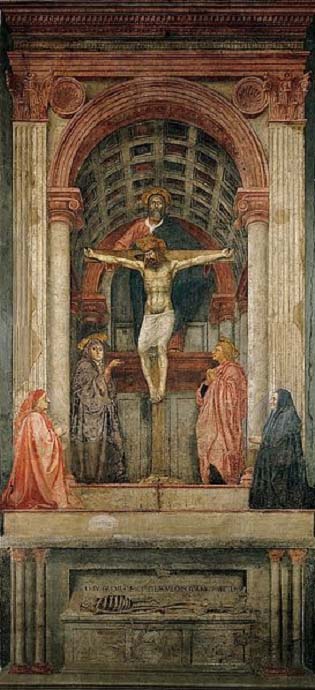
Masaccio, Trinity, 1426, S. Maria Novella Cathedral, Florence
Between 1425 and 1427 he frescoed a big Trinity (667 x 317 cm) at the S. Maria Novella Cathedral in Florence. Characters are presented as statues on different planes of an elaborate architectonic structure. Perspective rules assume a unique observer, placed in a central position in front of the painting, external to it but capable of interpreting it through senses and reason. The painting becomes a window through which one can have the sensation of seeing an actual space.
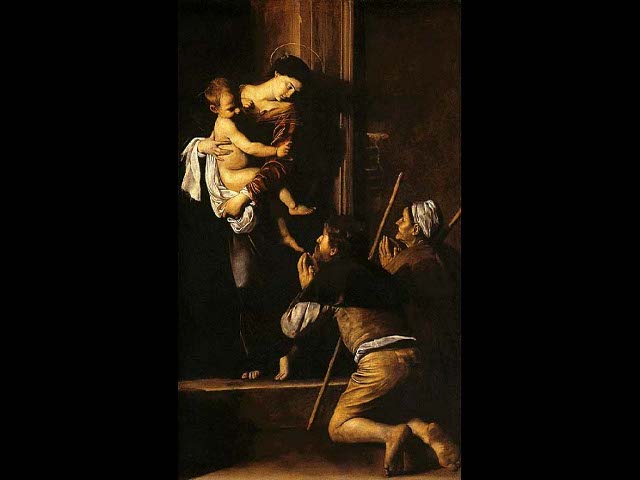
Caravaggio, La Madonna dei Pellegrini, 1605, San Luigi dei Francesi Church, Rome
Caravaggio, Mantegna and other Italian painters of the sixteenth century apply the perspective that avoids the original position, based on a central point of view for the observer. They build oblique frames, from the bottom or from the sides of the scene. They do not try to support the frontal observer vision, instead proposing unconventional points of view closer to anamorphosis. One of the main features of these original perspective structures is that they are part of a cold, rational technology. It is absolutely unemotional, neither inclusive nor participative, and it requires a distant observer that does not feel part of the representation.
B. During the period of Baroque style, architecture, sculpture and painting instead cooperated to constitute a tridimensional effect capable of involving the observer — who we can now call “spectator” — making him feel inside the representation. The Baroque building is projected to reach this inclusive, immersive and illusory effect. Sant’Ignazio Curch’s roof in Rome, work of the Jesuit painter Andrea Pozzo (1685), presents the Triumph of Sant’Ignazio inside an illusory building that ends in a sky populated by Saints and Beatified. The ideal point of view to view this work of art is a marked spot on the aisle floor.
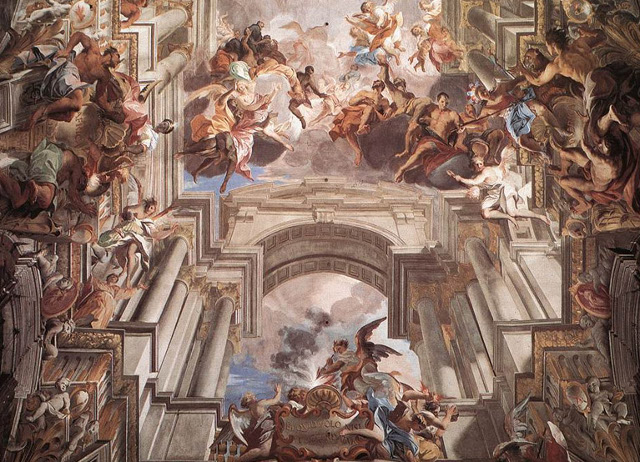
A. Pozzo, 1685, S. Ignazio Church, Rome
The perspective representation became a painting canon, and this form passed on to photography, for example in this 1952 photo by Henri Cartier-Bresson in the Italian town of Scanno.
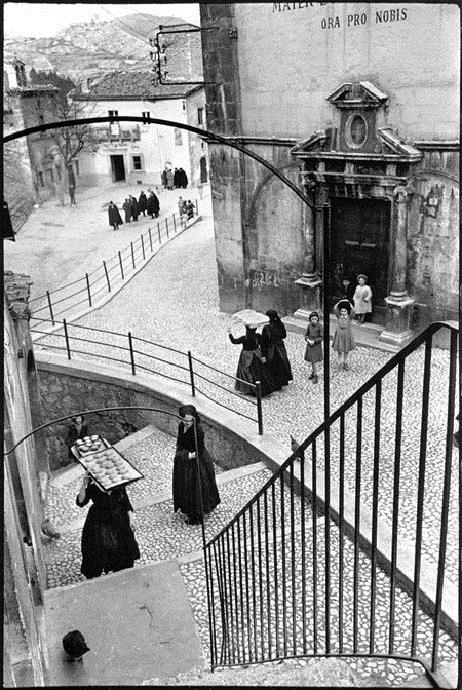
H. Cartier Bresson, Scanno, 1952
Stereoscopy, allowing an efficient view of the third dimension, started to be used near 1900, in particular for group images and landscapes, such as this 1890 photo by Fuhrmann.
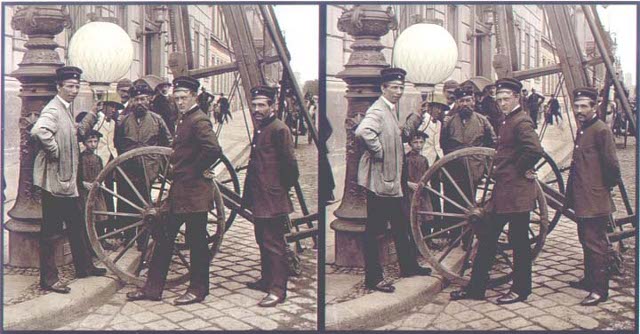
A. Fuhrmann, Stereotypy, 1890
Photography then handed down perspective rules to cinema, and cinema in turn passed them on to television.
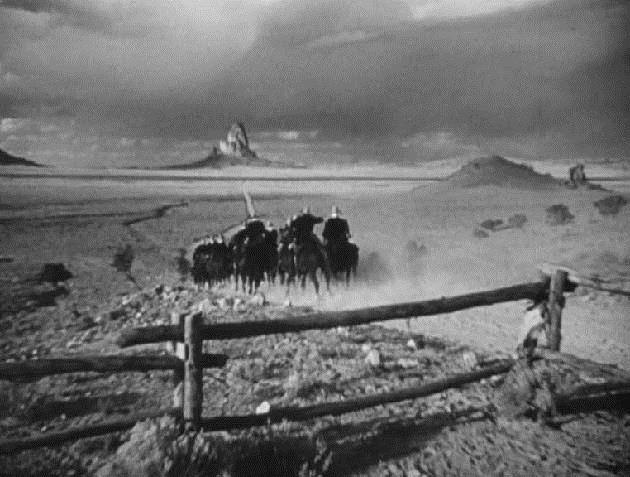
J. Ford, Stagecoach, 1939
Television never indulged in aesthetics very much because of its low resolution images, its smaller display, and its transmission of free content. Before the digital era, only one technical upgrade convinced the public to buy a new television set even if the one possessed was not broken: colour. All the others innovations—for example analogic high definition—never managed to reach that goal. Digital technology applied in distribution (DBS) created the pay per view system in the last decade of the twentieth century, not only offering widespread channels and a telephonic billing system, but also an efficient means of disseminating high valued specific contents to the mainstream public, creating niches for which they would be inclined to pay. . It is at this time that the quality of images started to be considered as a key factor. As we have already seen, these tendencies were fully stabilized around 2005, with broadband and flat screens, and they created a dominant cultural form for a scopic regime forged through over a century of mechanically reproduced images. Contemporary 3D recycles only the concept of stereoscopic shooting that brings the spectator inside the frame, an idea that moves the camera inside the character, dragging the audience in the story.
Cinematographic 3D is today not only an applied technology, it is also a tool for authors. Tim Burton’s Alicein Wonderland combines two different experiences and neatly merges them: on the one, hand live acting; on the other, motion capture.
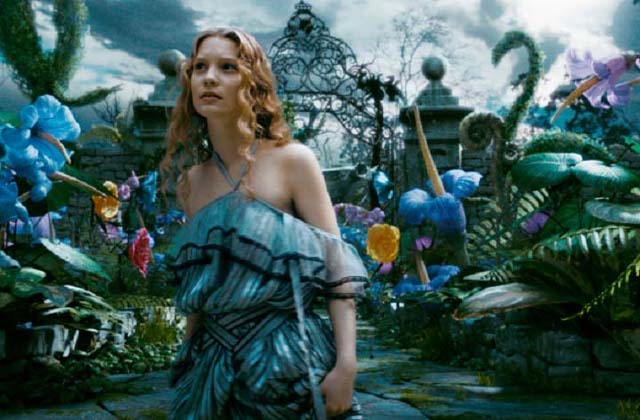
T. Burton, Alice in Wonderland, 2010
3D digital films are stratified composite images or, more precisely, a stratification in which it is possible to elaborate singular images. For Manovich, “The new media of 3D computer animation has ‘eaten up’ the dominant media of the industrial age – lens-based photo, film and video recording” (Manovich, 2008, p. 134). Images are no longer “time-based” but instead “composition-based” and “object oriented”.
In Hugo, Martin Scorsese uses a level of 3D absolutely functional to the imaginary tale. In this film, and in Wim Wenders’ Pina, the spectator is not immersed within the world but into the character.
3D technology is used in these films as a real tool to explore the characters’ psychologies. Directors figuratively accompany the audience inside the characters.
In Pina, the camera is not external; the shooting is the character. Technocrane and Steadicam movements alternate with a naturalness that resembles the real dancing practices of professional dancers.
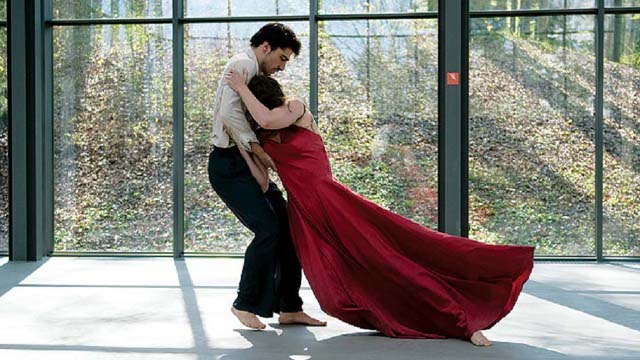
W. Wenders, Pina, 2011
Some cinematographic authors, however, did not realize that these evolutions changed production modes. Video games instead, when used as a source by films, have a crucial role. Platforms like the Nintendo Wii or tools like Microsoft Kinect for the Xbox 360 create real immersive perspectives for the players/spectators, with gyroscopes and kinetic sensors that read and translate their movements on the screen 4.
If 3D interests filmmakers such as Scorsese, Wenders and Burton, then it is no longer merely a blockbuster attraction. New aesthetic forms arise, circulating between cinema, TV and video, and delineate the visual and communicative landscape of this century. Digital 3D offers a new aesthetic convention through stereoscopy and binocular vision, above all genetically different from everything we have seen before. This topic is not yet a central one either in cinema or in television studies.
Our conclusion is that it is no longer possible to study media using the instruments of the past century. We must enlarge our horizons to study these new forms of total convergence. In the future, a multidisciplinary approach is needed in order to hypothesize new research directions, at least to consider the increasingly immersive visual conventions and cultures. In fact, these tend to create a scopic regime in which spectators, or perhaps only a part of them, “dive” inside the audiovisual content, stepping completely inside the story.
(The translation of this article was curated by Riccardo Fassone and Mauro Salvador)
References
Bolter, J. D., & Grusin, R. (1999). Remediation. Understanding new media. Cambridge, MA: MIT Press.
Jenkins, H. (2007). Convergence culture. Where old and new media collide. New York University Press.
Manovich, L. (2001). The language of new media. Cambridge, MA: MIT Press.
Manovich, L. (2008). Software takes command. Retrieved from http://softwarestudies.com/softbook/manovich_softbook_11_20_2008.pdf
– All images belong to their rightful owner. Academic intentions only.-
- Enrico Menduni, Antonio Catolfi, paper presented at Consulta Universitaria del Cinema annual Conference: En sortant du cinéma. Gli studi di cinema oltre in cinema, Università Roma Tre, Aula Magna, July 5, 2012. Enrico Menduni wrote the first paragraph, Antonio Catolfi wrote the second paragraph. Both authors revised and approved the entire text. ▲
- It is interesting to note that the American cutting-edge television system has been based, throughout the twentieth century, on NTSC technology, a standard developed in 1941 with fewer lines and lower quality compared to the European standard. The low quality of vision has never been considered an issue in establishing an effective and popular connection with the American audience. ▲
- Tommaso di Ser Giovanni di Simone, 1401-1428. ▲
- Wii interprets the player’s gestures through the movements of its remote used by the player. Kinect mounts two infrared cameras that stereoscopically read the actions in front of them. ▲

This work is licensed under a Creative Commons Attribution-NonCommercial 4.0 International License.
